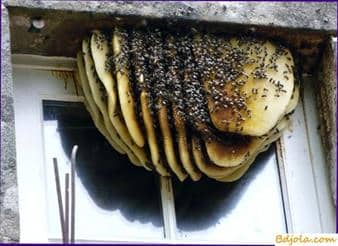
An extremely important role in the life of honey bees is played by the so-called chemical language – odors. This is the oldest and most perfect way to communicate insects. Their nest is full of aromatic substances. Nectar and pollen of different plants, fresh honey, propolis of birch, poplar, aspen, chestnut, wax, spirit spirit of bee venom, hormonal excretions of the uterus, bees and larvae all create a unique fragrant bouquet of the hive. This smell, special for each family, is the password. He serves as a pass to the home that bees returning home, according to which the hourly beehives identify bee-thieves or lost ones, distinguish their uterus from strangers who are unfamiliar to them.
The secret of the odorous gland located at the end of the abdomen, the bees are labeled with sources of nectar, pollen or water. Fly around these places, the bee-scout leaves a fragrant trail, according to which her sister-gatherers quickly find the source found. Also, bees point the way to a new housing.
The secret of the odorous gland also has another property. It can serve as a pass to someone else’s home, if the bee has lost its way and is looking for shelter in another house.
In the normal state, iron is closed. The bee, asking in another’s nest, opens it, lowering the tip of the abdomen and spreading the smell of the wings of the wings. The sentries peacefully let her into her house, and she becomes a full member of this family.
Densely covered with hairs, the bee’s body is saturated with the smell of flowers on which it has visited, and keeps it well. This is very important for other pickers, especially if this plant is of interest as a honey plant. By smell – the password entered into the nest, they from thousands of others find the right plant.
Hormonal secretions of the dermal glands of the uterus, which due to contact with her bees are carried throughout the nest, promote the unity of the family, activate its vital activity. A fragrant uterine substance is precisely the means that gives the family the cohesion in the actions of its numerous members, which we observe. It is worth the loss of the uterus, as in some 2 to 3 hours, or even earlier, a distress signal will work and the family will come to a strong confusion. Literally the whole population embraces anxiety.
According to the uterine substance, the bees accurately distinguish the uterus of the fetus, laying eggs, from the barren, not yet mated with the drones. Therefore, when replacing the young uterus or queen mother, instead of the old one, great caution is required.
By the secrets of the fragrant glands secreted by the larvae, the bees in the darkness of the hive can easily recognize their age and sex and give them a different food, corresponding to their growing body. Probably, the larvae from which the uterus develops have a different smell than the larvae of worker bees and drones, so the bees feed them with special, royal jelly.
In the bee nest as if arranged thousands of aromatic indexes, which bees use in their daily lives. Some show the location, the brood, and here come the young bees, nurses, others – the building site, and in this direction are the bees-masters with ready-made building materials – wax, the third indicate the honey compartment, and here, in the cistern cells, bees – loaders merge the nectar. Apparently, therefore, in the nest among a huge concentration of insects there is no confusion and crowd, and everyone is busy with their own business. Specific odor of the uterus attracts drones during mating flights. Even at an altitude of 20-30 m in 3-5 km from the apiary, the winged males quite soon find the uterus.
Smells, therefore, serve bees as a reliable means of communication, relationships, control their behavior.
In practical beekeeping, exciting odors are injected into the nest artificially to direct insect pollinators to plants poorly visited by bees and increase their yield. The bees are “trained”, in particular, on the testes of clover and alfalfa, on cucumbers and tomatoes, which are grown in greenhouses. To stimulate and activate flight and search energy, sometimes even odorous substances are injected into the hive, transferring frames from one family to another. After all, every family smells differently.
Пчелы в июне. Пчелы помидоры.
Young Beekeeper